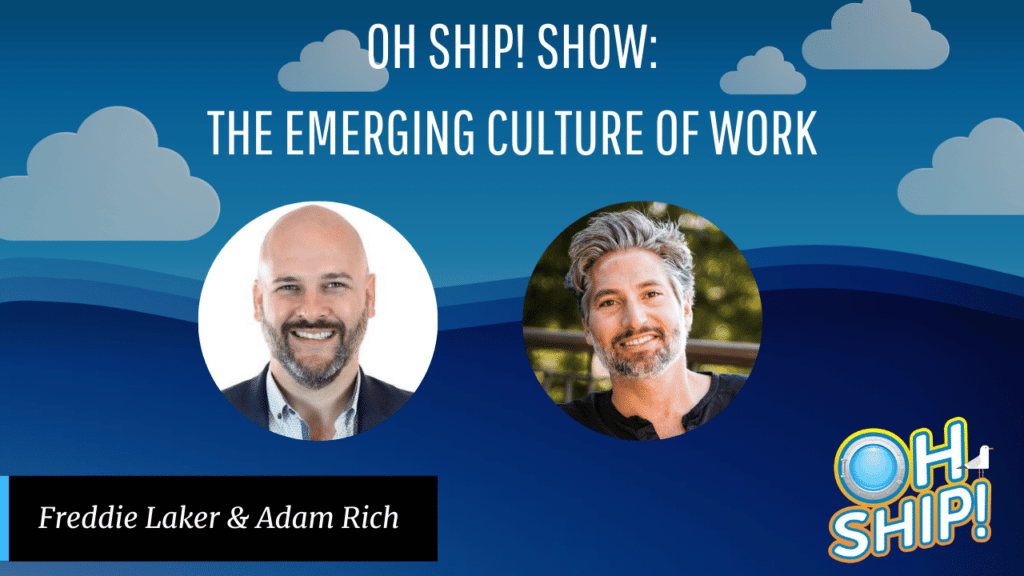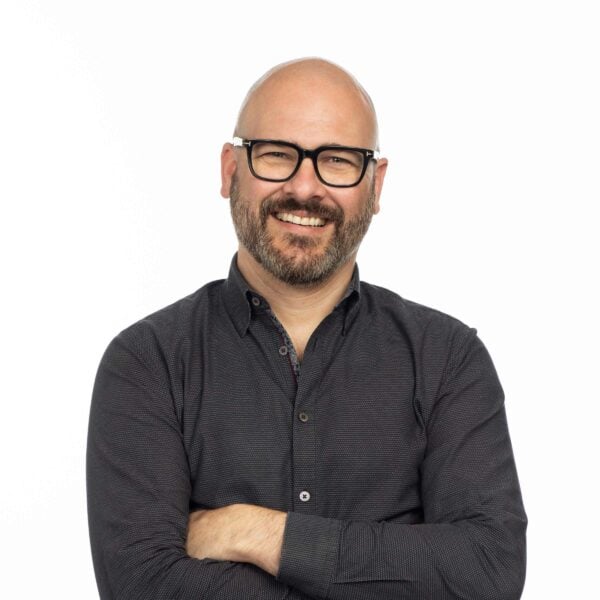Adam speaks on building trust and camaraderie in today’s workplace.
Adam Rich, founder of Thrillist and principal of Adam Rich Consulting, takes a deep dive with Freddie into the new norms around work environments, feedback loops in virtual and in-person configurations, and today’s best practices for intentional work and leadership. They tackled the question, “Is work broken?” and identified lessons learned from remote work that will benefit any team.
Adam knows a thing or two about leading remote teams. At Thrillist, founded in 2004, they used a hybrid working model from the beginning, gaining staff around the country who created newsletters about their local areas.
As they expanded, it sometimes felt like even the staff sharing their SoHo office were working remotely. Due to the nature of business space in NYC, they had offices staggered around the building. Their main space there had an open floor plan, making it a lively place—which could both help and hinder connectivity.
“In my experience, there is a sweet spot as far as the size of a thing like that,” laughs Adam. “I asked myself, ‘Is work broken?’ pretty regularly toward the end of my tenure with Thrillist when I would walk into the office, and there would be 150 people in an open pit with noise-canceling headphones Slacking each other from six feet away.”
It turned out that it wasn’t broken—they just needed to strike a better balance between space and proximity.
When is being in person essential?
Now, when people get together, they need to first figure out the ROI, says Freddie.
The office is a tool, and not everything requires an office, Adam agrees. But certain things definitely do. He shares his main reasons for meeting up with a team and which meetings leaders should avoid scheduling altogether.
Collaboration, communication, and persuasion
Unstructured collaboration and conversation work better in person, Adam asserts. “It’s the microcues; it’s hearing the person catch a breath, and you know that they’re about to speak; it’s all those little ways that the human animal is socialized to live in packs.”
Persuasion also suffers when working remotely, he adds—like when trying to close a deal or convince someone to embrace your point of view. The immediacy of an in-person interaction lends a certain gravity to the conversation.
“I think if it’s worth having, it’s worth having in person,” he emphasizes. For instance, a critical brainstorming session to set strategy is worth meeting up for in real life.
But it’s vital to first ask why a meeting is important. “There’s such a modern reflexiveness around making something into a meeting (…) this widespread notion of consensus being the way that you move forward in a modern and startup environment,” he says. “So many things that are meetings are actually a failure to delegate and trust, and a failure of leadership to choose metrics and stick to those things.”
Rather than holding a bunch of weekly meetings with the head of product, for instance, trust that person to do what the organization needs by giving clear specifications. Then look at the numbers as you go. In short, give people the freedom to make choices in their domains of expertise and then hold them accountable.
Building trust
Is a big reason to travel building trust and camaraderie, which tends to happen outside of meetings during meals and drinks? asks Freddie.
“Absolutely,” says Adam. “People trust people. People don’t trust proposals, decks, or strategies. (…) People who have been in the office and have now gone remote have a real advantage over people who met one another remotely.”
“What’s an office for?” we need to ask. This can lead to creative new arrangements, he notes. For example, two companies could share an office, each getting exclusive use one day a week and sharing it on the other days as a coworking space.
“For that one day a week, you get in there—no computers; everybody’s using a pad and pencil, you’re in meetings. You cluster all the off-site stuff, all the collaborative stuff (…) using the fact that [you’re] IRL to basically generate a lot of alignment, a lot of consensus, a lot of new ideas.”
What cultural trends are improving things; which ones are making things worse?
“Work culture is something that very few places have figured out how to translate into an all-remote, all-digital modality,” Adam emphasizes.
There are two main levels of trust, Freddie posits—and this is becoming increasingly apparent. At the first level, you trust people to be accountable professionally. At the second, you deeply trust them as a person because you know who they are. This affects the way we lead people—and in particular, how we give and receive feedback.
“Feedback is inherently risky, right? If it’s actually worth saying, it’s gonna be something that is delicate,” Adam says. “It’s got high stakes if it’s any kind of real feedback.” If you have a foundation of that kind of trust, people will be able to hear it.
In an office, you’re passively consuming people’s interactions with others, which also affects trust, notes Freddie. That’s one of the major challenges of remote work, Adam agrees. “You end up, in an office, gathering all this bycatch information,” he says. “You see the way that the person is talking to somebody else, and you overhear what’s going on in their conversation; you catch wind of a project that you’re not part of, but it helps keep you aware of what’s happening across the company. And that kind of loss of the bycatch really robs you of a lot of broader context.”
“Some of that context is, what’s this person like? Or can I trust this person? Or is this guy a good guy?” he continues. “Because maybe they’re being nice to me, but I’m their boss. And maybe they’re being really awful to the people that have to answer to them.”
What parts of remote work should we strive to retain?
In other words, if we went back to “normal,” should we go back to meeting culture? Should employees be evaluated partly on whether they’re sitting at a desk or solely on whether they complete their job? Adam asserts it should be strictly the latter—a lesson he learned early on with Thrillist.
When Thrillist launched their LA edition, they hired an employee in LA. Before then, it had been him and a few people around a table in a shared workplace. They didn’t have a real relationship yet with the guy in LA.
“What do I need out of this role?” he asked himself, saying, “Let’s be super-specific. What is the deliverable, when do I need it by, what makes it good?” He had to take a step back and be much more intentional about showing trust. He realized he didn’t need to know what time the guy started work. He had to say to himself, “I care about getting this, and I can’t care about the rest of that stuff.” That was critical to his success as a manager, and he tried to apply it to in-person employees as well, giving them the freedom to get work done as they saw fit.
The LA employee ended up working for Thrillist for over ten years and became a personal friend of his.
Wise employers are learning that they’re buying outcomes, says Adam. “They’re getting the impact; they’re getting the result that they’re buying. I think that is a major step toward one’s lifestyle becoming more human and being more based around one’s individuality,” he asserts.
“The process is frankly not your business,” Adam says. “If there are things about the process that you really object to, then if they matter, you should be able to measure them in the outcome.”
Creating a more personalized, boutique work experience might be becoming the new normal, adds Freddie. This means helping people build their jobs around their life rather than the reverse.
How can leaders build solid relationships with freelancers?
In purely remote relationships, things can become very transactional, says Freddie. We can crank out more work and pack in more meetings, but the social element takes a backseat to productivity, and that affects trust.
But does that mean work is broken? And if so, how can we fix it?
With remote work, the same rules apply as in real life: Make the time to get to know people, Freddie says.
Freddie makes an effort to talk with everyone who has interacted with Chameleon Collective. “I want to be a good steward and representative of the company’s culture,” he says. “I want them to see me as an extension of that culture. I want to make sure that they’re aligned with that culture.”
“Don’t think of remote as any different than real life—it’s all about making time for people, and you just have to do it,” he asserts.
Whether in person or remote, leaders need to be more intentional about investing in their people. That’s been one of the greatest joys of being an entrepreneur for Adam.
“Finding people, and investing in them, and giving them a challenge, and letting them do it, and helping them kind of work through it—that was, I think, probably one of my greatest pleasures in having built Thrillist,” he says. “People don’t just wake up one day knowing how to navigate.” Put in the extra effort to do that with remote people—nurturing rather than micromanaging—and you’ll build genuine bonds of trust, no matter what side of the country or planet they’re on.
Did you enjoy this conversation? Like and subscribe for more insightful content from inspiring entrepreneurs!







